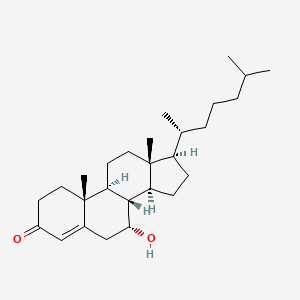| MeSH term | MeSH ID | Detail |
|---|---|---|
| Cholestasis | D002779 | 23 associated lipids |
| Xanthomatosis, Cerebrotendinous | D019294 | 14 associated lipids |
7alpha-Hydroxy-4-cholesten-3-one
7alpha-hydroxy-4-cholesten-3-one is a lipid of Sterol Lipids (ST) class. The related lipids are Steroids and Cholestenones.
Cross Reference
Introduction
To understand associated biological information of 7alpha-Hydroxy-4-cholesten-3-one, we collected biological information of abnormalities, associated pathways, cellular/molecular locations, biological functions, related genes/proteins, lipids and common seen animal/experimental models with organized paragraphs from literatures.
What diseases are associated with 7alpha-Hydroxy-4-cholesten-3-one?
There are no associated biomedical information in the current reference collection.
Possible diseases from mapped MeSH terms on references
We collected disease MeSH terms mapped to the references associated with 7alpha-Hydroxy-4-cholesten-3-one
PubChem Associated disorders and diseases
What pathways are associated with 7alpha-Hydroxy-4-cholesten-3-one
There are no associated biomedical information in the current reference collection.
PubChem Biomolecular Interactions and Pathways
Link to PubChem Biomolecular Interactions and PathwaysWhat cellular locations are associated with 7alpha-Hydroxy-4-cholesten-3-one?
There are no associated biomedical information in the current reference collection.
What functions are associated with 7alpha-Hydroxy-4-cholesten-3-one?
There are no associated biomedical information in the current reference collection.
What lipids are associated with 7alpha-Hydroxy-4-cholesten-3-one?
Related references are published most in these journals:
| Lipid concept | Cross reference | Weighted score | Related literatures |
|---|
What genes are associated with 7alpha-Hydroxy-4-cholesten-3-one?
There are no associated biomedical information in the current reference collection.
What common seen animal models are associated with 7alpha-Hydroxy-4-cholesten-3-one?
There are no associated biomedical information in the current reference collection.
NCBI Entrez Crosslinks
All references with 7alpha-Hydroxy-4-cholesten-3-one
Download all related citations| Authors | Title | Published | Journal | PubMed Link |
|---|---|---|---|---|
| Rao AS et al. | Chenodeoxycholate in females with irritable bowel syndrome-constipation: a pharmacodynamic and pharmacogenetic analysis. | 2010 | Gastroenterology | pmid:20691689 |
| Steiner C et al. | Quantification of the 15 major human bile acids and their precursor 7α-hydroxy-4-cholesten-3-one in serum by liquid chromatography-tandem mass spectrometry. | 2010 | J. Chromatogr. B Analyt. Technol. Biomed. Life Sci. | pmid:20869337 |
| Walters JR | Defining primary bile acid diarrhea: making the diagnosis and recognizing the disorder. | 2010 | Expert Rev Gastroenterol Hepatol | pmid:20932141 |
| DeBarber AE et al. | ESI-MS/MS quantification of 7alpha-hydroxy-4-cholesten-3-one facilitates rapid, convenient diagnostic testing for cerebrotendinous xanthomatosis. | 2010 | Clin. Chim. Acta | pmid:19808031 |
| Schreuder TC et al. | The hepatic response to FGF19 is impaired in patients with nonalcoholic fatty liver disease and insulin resistance. | 2010 | Am. J. Physiol. Gastrointest. Liver Physiol. | pmid:20093562 |
| Odunsi-Shiyanbade ST et al. | Effects of chenodeoxycholate and a bile acid sequestrant, colesevelam, on intestinal transit and bowel function. | 2010 | Clin. Gastroenterol. Hepatol. | pmid:19879973 |
| Björkhem I and Hansson M | Cerebrotendinous xanthomatosis: an inborn error in bile acid synthesis with defined mutations but still a challenge. | 2010 | Biochem. Biophys. Res. Commun. | pmid:20494109 |
| BÃ¥vner A et al. | On the mechanism of accumulation of cholestanol in the brain of mice with a disruption of sterol 27-hydroxylase. | 2010 | J. Lipid Res. | pmid:20511491 |
| Kovár J et al. | Regulation of diurnal variation of cholesterol 7alpha-hydroxylase (CYP7A1) activity in healthy subjects. | 2010 | Physiol Res | pmid:19537927 |
| Drury JE et al. | Characterization of disease-related 5beta-reductase (AKR1D1) mutations reveals their potential to cause bile acid deficiency. | 2010 | J. Biol. Chem. | pmid:20522910 |
